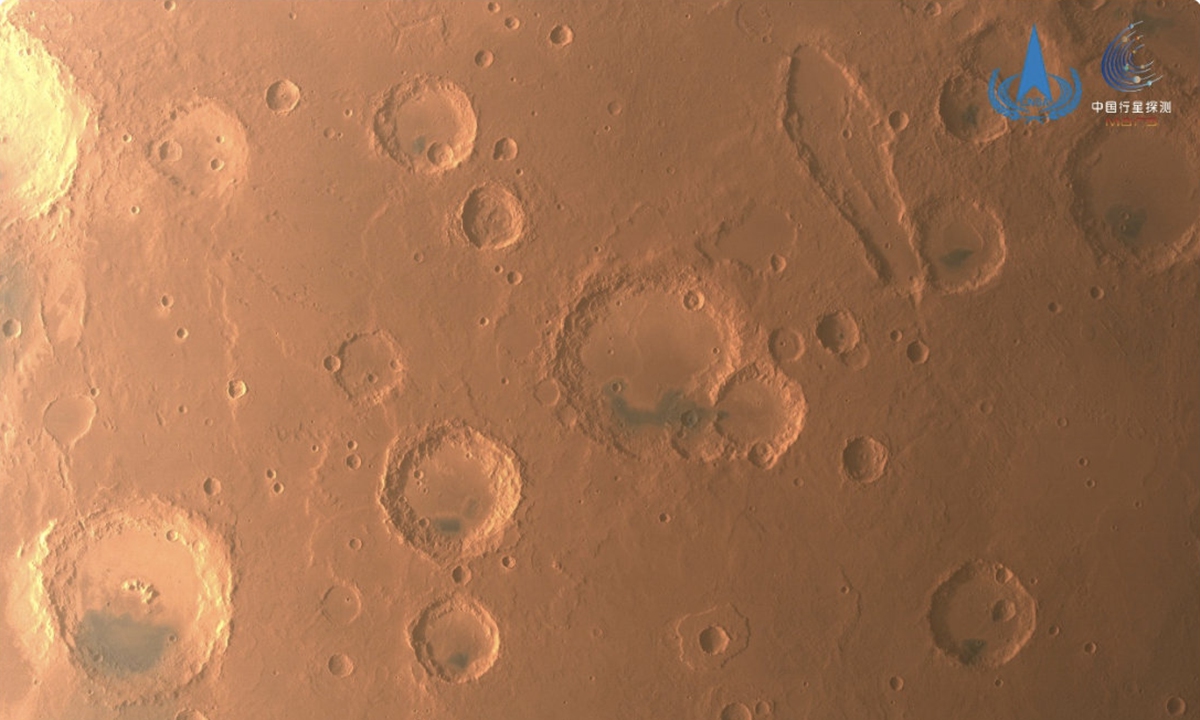
Craters on the surface of Mars photographed by the medium-resolution camera of Tianwen-1 orbit Photo: Sina Weibo
China National Space Administration (CNSA) on Wednesday released the latest batch of Mars images taken by the country's Tianwen-1 probe and announced that the mission has accomplished all its assigned tasks as of Wednesday, obtaining data of medium-resolution covering the entire red planet and achieving exploration assignments with a variety of scientific payload.
After two years' operation and explorations of the planet by Tianwen-1 Mars probe, the 13 pieces of scientific payload installed on the probe have obtained 1,040 gigabytes of original scientific data.
The data, after being processed by the ground team, formed standard scientific products and have been handed over monthly to scientific research teams for further analyses and studies. Relevant scientific achievements have been published in well-known academic journals both at home and abroad.
The scientific data will be available to scientists around the world at an appropriate time and scientists are welcome to apply for research over the data so as to jointly promote mankind's exploration of the universe, the CNSA said.
Since its successful launch on July 23, 2020, the probe traveled 475 million kilometers into the deep space in a period of 202 days, and entered Mars orbit on February 10, 2021.
After a three-month investigation into the designated landing areas, the probe landed on Mars on May 15, 2021. The probe's rover Zhurong was released onto the surface of Mars and started the roving mission on May 22, 2021.
As of August 15, 2021, the rover had accomplished assigned scientific exploration tasks within 90 days on Mars.
Zhurong continued its exploration missions and has trekked on the surface of Mars for a total of 1,921.5 meters.
The rover entered a dormant mode on May 18 due to extreme cold and strong sand and dust weather in its landing area in face of the Mars winter. It is expected to resume operation around December of 2022 when the landing area of Zhurong enters early spring and the environmental condition gets better.
Tianwen-1's orbiter has been orbiting Mars for 1,344 rounds, realizing a global coverage. It will continue its remote sensing of the planet and select opportunities to carry out the extended technical tests, conducting technical validation for related tasks in advance.
In the spirit of open and shared cooperation, CNSA has actively promoted cooperation with space agencies and scientific communities from other countries. It has shared the data of the Mars' orbiter and conducted cooperation on collision warning with US National Aeronautics and Space Administration (NASA) and the European Space Agency (ESA).
The Zhurong rover cooperated with ESA's Mars Express orbiter to perform a radio test of data relay, realizing the scientific data relay cooperation of Mars between China and Europe.
Besides, CNSA has cooperated with observatories in many countries, such as those in Russia, Germany, Italy, Australia and South Africa to carry out observation and scientific researches on fields including solar wind around the solar outage via Tianwen-1 orbiter and Mars Express.
Such cooperation has yielded good results, enriched human knowledge and made positive contributions to building a community of shared future for mankind in the scientific field, according to the CNSA.
Global Times




